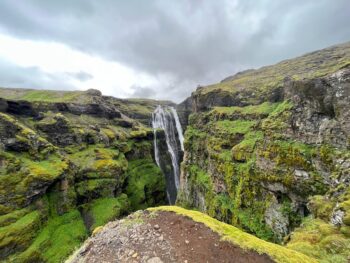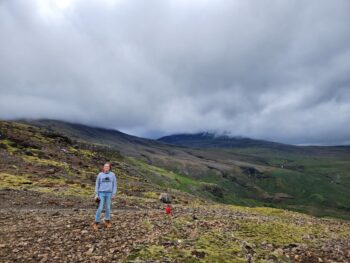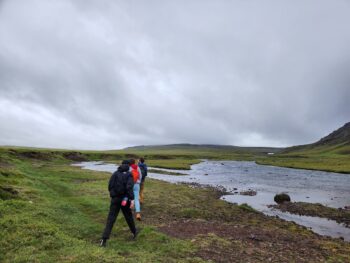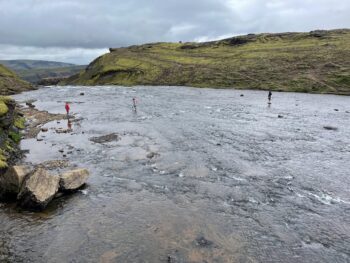 By Jack Hurbanis
By Jack Hurbanis
This summer, on the way to visit family in Slovakia for the first time since before the pandemic, I got to spend two and a half glorious days in Iceland. My traveling partners and I landed about a week after the summer solstice – meaning for the entire time, we never saw the sun set.

Glymur Waterfall
We got to visit Reykjavik, see bubbling sulfur-filled geothermal pools, relax in hot springs next to the freezing cold ocean, touch the point in which the North American and Eurasian tectonic plates meet, watch a volcano erupt, and find the natural beauty that seems to hide behind every corner on this sparsely populated island.
The most awe-inspiring and challenging moment was our hike to see Glymur Waterfall.
“I came to learn there is no wrong way to do this beautiful hike.”
As a community organizer, it may not shock people that I like to plan ahead and be overly prepared. In our trip preparations, I researched hikes to do while in Iceland and that’s how I came across the hike to Glymur. I read countless reviews, looked at photos, and came to learn that there were dueling opinions on the best way to hike the 4.1-mile loop up and back down the 1305 feet of elevation change. After discussing with my hiking partners, we decided that we thought the arguments being made by the group of people encouraging site-seers to hike the trail counterclockwise were the most compelling and that’s the route we would take.
WE ARRIVED IN THE parking lot at 10 a.m. After stopping several times on the way to take pictures with roaming bands of sheep, we stared at the map written all in Icelandic. Wanting to take charge as an activity I suggested and planned, I looked at the arrows pointing to take the first right and confidently said “remember, the reviews said go counterclockwise, so we’ll take a left at the split and hike up from there.” For those reading this and who understand circles better than I do, going left at any point in a circle is in fact going clockwise – but my brain made the connection “counter” equals “opposite,” so we’ll go the other way. I didn’t realize my mistake until we were about 100 yards from the car.

Jack on his way up the mountain
I came to learn there is no wrong way to do this beautiful hike. I feel fortunate, after walking up and getting to experience mountains that have been carved out by streams of water for thousands of years, to have a gorgeous 650-foot waterfall revealed after crossing the coldest and clearest river I’ve ever seen. I could walk the second half accompanied by the rushing sound of the waterfall and increasing feelings of “wait, we just came from all the way up there? That’s so high!”
“One of my hiking partners remarked that three sheep were walking farther north along a small path and that if the sheep are going that way, it must be safe to follow.”
The only hitch was that if you hike the opposite way from what you researched, when they tell you there will be a log to cross on the first river cross and that you’ll have to wade through the second one, you need to also reverse these expectations as well.
When we arrived at the first river, seeing no log anywhere in sight, we figured this must not be the crossing site. This hike did not come with labeled markers, just a worn trail and the occasional post to keep your faith that other humans have also been where you currently are. This was the correct crossing site which we were supposed to gather from the two small metal rods on either side of the bank.

Jack and his friends following sheep along the river
One of my hiking partners, a friend who I’ve known and lived with since the first day of college, remarked that three sheep were walking farther north along a small path and that if the sheep are going that way, it must be safe to follow. Seeing no flaw in that logic, we walked for an extra mile and a half along this beautiful river I later learned is called the Botnsa.
After arriving at a waterfall that was not the one we were looking for, we turned around and decided just to try our luck crossing at the original spot – which led us directly to the reveal of Glymur. It was almost unsettling not being able to hear such an enormous waterfall until you could suddenly experience the rush and see the cavern it has carved out. While there was really no danger in slipping and getting pulled under as the river crossing was mostly shallow and had no strong currents, it was similarly unsettling to realize I was 500 feet upstream from the mouth of Glymur without knowing.
The descent going clockwise was more difficult than it would have been if we had gone counterclockwise, but after four hours and nearly seven miles of hiking we made it back to our car and headed off to lunch laughing about how long it took us to realize such a simple mistake and that we actually think the hike was better the way we did it.
BY THE TIME you are reading this blog, my time on synod staff will have ended. With the upcoming transition and my heading off to become a full-time law student, I’ve reflected on my Glymur hike and have thought about how the best things in life don’t have a wrong way to do them.

Jack and friends crossing the river
I’ve made many plans in my life, sticking to them maybe 33% of the time, and sometimes the mistakes are what have allowed me to get to have incredible experiences. In just a year and half as Congregational Organizer for Environmental Justice, there are about a million things that didn’t go as planned, but that didn’t stop us from filling a room at the Minnesota Public Utilities Commission to fight for more investment in energy efficiency upgrades, or from hosting our first Minneapolis Area Synod EcoFaith Summit at Diamond Lake Lutheran, or from being part of the coalition that passed 100% Clean Energy by 2040 in Minnesota.
“Sometimes the mistakes are what have allowed me to get to have incredible experiences.”
I am excited about my future plans and to see how they go awry, and I know the Minneapolis Area Synod EcoFaith Network is going to continue making great plans and even better adaptations.

